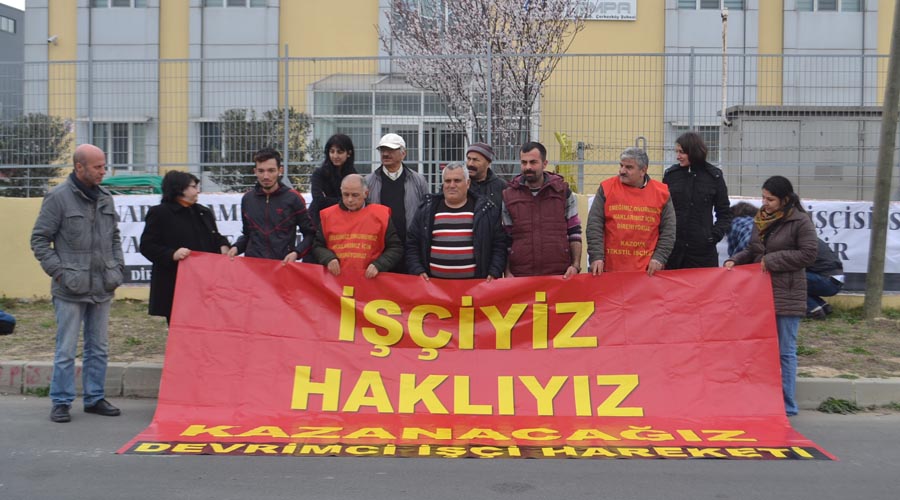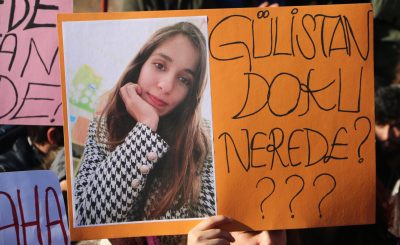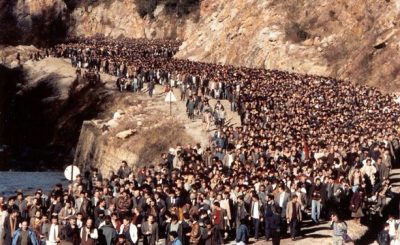Figures:
Turkey has 70 million citizens, of which 20 million are employed, of which 10 million are insured workers (including their relatives and the pensioned people), of which 1 million are organised in union, of which 300.000 are members of DISK (Revolutionary Workers Union Confederation)
Hindrances for union work:
- To participate in collective negotiations, a union must represent at least 10% nationally of the workers in a certain sector.
- In a factory, a union must represent at least 50% of the workers. To become member of a union, this has to be testified by a notary -which costs money-. The Department of Social Affairs must check these numbers and confirm them. When this is not done, the union needs to take legal action. In case of a confirmation by the department, a entrepreneur can appeal. This procedure can take 6 months. During this period, the entrepreneur can sack the union members, reducing the level below 50%.
- The State has the right, at any time, to prohibit a strike for “state interests”, as happened in 1995.
- Unionists are subjected to all kind of repression: “disappearances”, arrests and torture. Getting elected as union official is impossible after a jail sentence.
- The state does not pay, or only in part, the contributions to the unions, depending on the number of members.
What kind of unions are there?
Turk-Is: State union. The only union which was allowed after the military coup in 1980, therefore it has the largest number of members.
DISK: had 600.000 members before the coup. Banned in 1980, its officials were prosecuted.
HAK-Is: Close to the Refah Party. Relatively small and playing just a subordinate role in the workers struggle.
KESK: Civil servants union, founded in 1995. Since 1982, it was forbidden for civil servants to organise in unions. Despite this ban, revolutionaries founded Bem-Sen (Union of Communal Administrations), Saglik-Sen (Union for Health care workers), KAM-SEN (Union for public servants) in the form of associations in 1989. They did not limit their struggle to economical demands, and in 1992 they were banned again. Many were arrested, tortured, or “disappeared” like Aysenur Simsek in January 1995 (chairperson of Saglik-Sen in Ankara). However, the unions were always founded again, despite the repression, using similar names. One year ago, the ban to found unions was lifted after national and international pressure. However, means of pressure like strikes are forbidden and political items may not be addressed. Thus the civil servants unions, with the exception of the revolutionary unions, look more like social clubs.
What unions in what sectors can be called revolutionary?
After the military coup in 1980, all democratic organisations, therefore also the unions, were banned. Only Turk-Is, in reality an extension of the state, was allowed to continue. But because this was the only way to organise, in some sectors the progressive forces got the upper-hand. These were: Liman-Is (harbours), Hava-Is (airports), Deri-Is (leather), Basin-Is (print), Petrol-Is (oil), Tum-Is (Transport), and Harb-Is (weapon industry). However, these sectors were relatively small and therefore of limited strategic importance. The main sectors remained in the hands of the fascists: Turk-Metall-Is (metal), Dok-Gemi-Is (harbours), Seker-Is (sugar), Tes Is (energy), Orman-Is (wood), Koop-Is (retail), Turk-Haber-Is (press agencies), Teksif (textile)
Because of this situation, it sometimes happens that parts of Turk-Is are more revolutionary than there counterparts in the DISK. The most progressive unions are: Deri-Is in Tuzla (Turk-Is), Genel-Is (workers in communal administrations) and Nakliyat (transport), both of the DISK.
The best collective contracts exist in the sectors: Oil, plastics, metal and mining, communal administration. Civil servants usually earn less than workers because they did not have the opportunity to organise themselves (since 1980) and they could not a struggle for higher wages. This had of course its side-effects: a civil servant has to be corrupt in order to feed a family.
History.
The history of the workers movement is a long one and books could be filled with it. Here are just a few examples to give an impression of the reality in Turkey:
Because of the feudal structures, which in part prevail even today, capitalism starts to develop relatively late, therefore the organising of the workers and the workers struggle starts to develop quite late as well.
There are strong impulses because of the adjacent Soviet Union, but the first communist party, TKP (founded in 1920), still believes the revolution can be achieved by democratic means.
1923: An army, led by patriots, wages an anti-imperialist war of liberation. After their victory, they start to oppress the opposition, including all communist organisations. Unions and strikes are banned.
1950: The DP – Democratic Party -, supported by the USA, wins the elections, promising the right to strike, support of the agricultural sector, fighting inflation. However, the right to organise for workers and peasant organisations is abolished again as soon as the people really start to organise themselves. The opposition grows, left wing parties are founded and draw much support.
May 22, 1960: The coup of patriotic generals leads to a relatively democratic constitution. This constitution is approved in a plebiscite by 61%. During this time, many left wing parties emerge. Left wing and communist literature is translated into Turkish. The two largest movements are:
- YON – Bourgeois Nationalist Tendency: nationalist, anti-capitalist, intellectual, but not socialist. Accepts socialism, but rejects class struggle. This movement dissolves after the military coup in 1971.
- TIP – Turkish Workers Party: founded in 1961 by unionist. Did a lot of education among peasants and workers. In its program they plan the victory of the party by democratic elections, the demolition of imperialism and the transformation to socialism.
1965: After the murder of 2 miners by the police during the strike in Kozlu, a silent march is organised. Thousands of people participate. The student participate as well in a organised form.
– Since then there is a strong bond between the workers and the student organisations –
1967: DISK – Devrimci Isci Sendika Konfederation (Confederation of Revolutionary Workers Unions) is founded. In 1980 it had become a mass organisation with 600.000 members. However, its struggle was limited to economic demands.
1969: The youth movement “Devrimci Genclik” breaks through the parliamentary reformist policy of the Turkish left and it influences the workers movement. June 15-16, 1969: General strike. With 800.000 participants, this became the largest manifestation in the history of Turkey. The strike is aimed against a proposed law which would only allow unions to represent insured workers in a certain sector if they would organise at least 1/3 of these workers in the whole country. Thus all democratic and revolutionary unions would be eliminated. The demonstrations end in a massacre: the police opens fire against the crowd at random.
March 12, 1971: The new military junta describes the constitution of 1961 as “too liberal”, and it is abolished. The state of emergency is declared, all democratic organisations are banned, the freedom of organisation, press and information are abolished, many books are forbidden.
1973: A new civilian government is put in power. Many important positions are occupied by fascists who continue their terror against the population.
1974: Despite the ban on strikes, DISK is able to organise a strike with 100.000 workers.
April 24, 1975: The worker Abdi Omen gets wounded during confrontations. The police arrests him, but he is not brought to hospital and he bleeds to death. During the protests against this murder, the police uses armoured vehicles, guns and grenades. The people resist with bricks and Molotov-cocktails.
1977: The process of organising reaches it zenith.
May 1, 1977:In total 250-300 thousand people take part in the demonstration. The police opens fire against the crowd, killing 34 people. Streetfights emerge.
1978:The massacres by civic fascists against the people increase. “Devrimci Sol” (Revolutionary Left) emerges, connecting the workers and the student movement, waging the armed struggle, following the example of the THKP-C (Turkish People’s Liberation Party-Front).
September 12, 1980: MILITARY COUP.
With this military coup, the imperialist react against the growing organisation of the people. All democratic organisations are banned, hundreds of people are murdered, thousands are arrested, numerous people go into exile. Some 1.000 officials of DISK are arrested.
1984:Death Fast by the political prisoners, lasting for 73 days. 4 comrades die in this strike, but it gives the people outside the prison strength again to continue the fight.
1987: Strike at Migros. This strike, led by the 3. district of Teskoop-Is (of which Aynur Karaaslan is chairperson) was the first workers struggle after the military coup which would be successful. This is an indication for the developments in later years in which women emancipate and increasingly start to take over their responsibility in the revolutionary struggle.
– Aynur Karaaslan started her union activities in 1977. Until 1980, she worked in the independent union PAKSAT-IS. The trial against her, started by the military junta, ended in 1983. Together with her friends, she organised in Turk-Is. After a tip by the Political Police, she was expelled in 1989. Now she works for DISK-Genel Is in Istanbul –
May 1, 1987: Despite a ban, the people take to the streets again and demand their rights. Salih Kul and Ozturk Acar are shot.
1988: Spanish print workers are on strike. Therefore the money is going to be printed in Turkey. In solidarity with the comrades in Spain, the workers refuse this work. May 1, 1988: Despite the repression and the massacres in the previous years, 5.000 students and workers march to Taksim square. The police intervenes. Barricades are put up, streetfights emerge.
May 1, 1989: Again thousands of workers, students and inhabitants of the Gecekondus gather to demand their rights. The student M. Akif Dalci is shot by the police.
1991: The ban against the DISK is lifted.
January 3, 1991: The whole people shows its opposition against the Ozal regime. With a general strike they protest against the imperialist war, and show their support for the miners. Workers and civil servants put down their work. Shops remain closed, busses and mini-busses strike. Housewives symbolically show their empty pots, the garbage is not collected, even the merchants in the Bazaar are keeping their shops closed. Some universities remain totally empty. August 1991: The strike and the factory occupation by 12.000 glass workers in Pasabahce/Istanbul against the sackings is successful. The workers of the glass factory are supported by the civil servant unions (Bem-Sen, Saglik-Sen), also financially. Their is broad support among the population.
– This is just one example of the solidarity between the workers in several sectors, the toilers, civil servants, students and artists. (Frequently, there are solidarity meetings for the relatives of sacked workers where artist perform for free.) –
March on Ankara: 100.000 miners from Zonguldak march to Ankara for days. Everywhere they are welcomed and provided with food and drinks. They demand higher wages and social security.
Statistics 1995: In the statistics world-wide of deadly accidents in the mining industry, Turkey leads with 119 deaths for every 1 million ton of coal. Second on this sad statistics comes Pakistan with 30 deaths. This imbalance, compared to countries with a relatively high grade of education and modern technology, such as in Europe, can be explained like this: the imperialists (in this case from England), who own a large part of the mines, haven’t invested for years in modernisation and security measures. Fascism makes sure the workers can not organise themselves. –
May 1, 1992: The MayDay demonstration is allowed this time. The authorities gibe in to the pressure of the people who, despite the repression and the massacres, take to the streets on MayDay each year in ever increasing numbers.
1993: Proclaimed as Year of the Strikes by the DISK.
Because of the conditions of the IMF though, it becomes a year of mass sackings. Successes: – The 341 sackings of city workers in Kagtithanse are withdrawn after a march to Ankara and a hunger strike. – The administration of Kucuk Cekmece/Istanbul has to pay the withheld wages after 80 days of resistance and demonstrations of the workers. – Turbo Filter in Mersin sacks 80 unionists who demand better working conditions. After a strike by the workers, they are employed again. – 600.000 workers make “doctors visits”, meaning that workers go to their doctors collectively to get a declaration of illness in order not to go to work.
May 1, 1993: More and more people participate in the demonstration each year. In the ranks of Devrimci Sol, 6.000 people march.
January 10, 1994: 300.000 civil servants in the whole country protest for their right to organise themselves in unions. In Ankara, armed policemen attack the demonstration, several people are wounded.
January 13, 1994: The protests of the civil servants continue in all major cities. In total 10.000 civil servants strike on this day.
April 5, 1994: Ciller signs a new contract with the IMF, which would lead to new privatisations, price increases, and thousands of factories closed down.
April 11, 1994: 70.000 miners demonstrate in Zonguldak against the closing of the pits and the privatisation.
April 12, 1994: In Gebze, 7.000 workers from the steel- and glass factories demonstrate in solidarity with the miners in Zonguldak.
April 24, 1994: 15.000 workers from the steelworks in Karabak protest against the closure of their plant.
July, 1994: 50.000 civil servants from all major cities march in Ankara, demanding the right to organise themselves in unions.
July 20, 1994: General strike against the April 5 package, 4 million people participate. This general strike was practically organised by the grass root organisations in the unions and the neighbourhoods, associations and students because the leadership of several unions do call for a general strike, but do not organise it factually.
January 24, 1995: 200.000 workers march in Ankara against the consequences of the April 5 package.
May 1, 1995: From the 100.000 participants in the demonstration, 15.000 march under the banners of the DHKP-C (formerly known as Devrimci Sol).
May 16, 1995: After the Refah Party wins the elections in Eminonu, it appoints its own followers, sacking 260 workers. For 258 of them, protective measures apply (for instance: people who are just 5 years from their pension may not be sacked). The workers start their resistance, supported by their families, colleagues and the population. 3 members from Genel Is start a death fast. This measure is necessary because the city administration, controlled by the Refah Party, is sacking more and more workers. On the 101. day of the resistance and the 34. day of the Death Fast, the city has to give in, and the 180 workers who had not taken another job till then, are re-employed.
October, 1995: Despite the inflation of 139%, the government only grants small wage increases in the negotiations with Turk Is for the workers in the food industry. Because of the pressure by the workers, Turk Is is forced to call a strike. When the government tries to import food from abroad, the harbour workers join the strike. The transport workers, car factory workers, metal workers and workers from all unions follow. At the height of the strike, 600.000 workers participate. This causes a major crisis for the government. In the end it bans the strike “for national interests”. Turk Is does not resist, accepts the small wage increase, and orders the workers to go back to work. An official who openly calls the link between the state and Turks Is “collaboration” is arrested. Turk Is refuses him any kind of help.
October 21, 1996: The textile worker Duzgun Tekin, an active DISK-Textil Is member “disappears”. After he was followed by plainclothes police for already one week, he was never seen again after he left his house at 7 o’clock.
March 12, 1996: At the anniversary of the uprising in Gazi/Istanbul, in which 40.000 people participated, and more than 40 people were killed, there are strikes at all universities in the country. The population takes to the street. In Gazi alone, 30.000 people march.
May 1, 1996: 100.000 people take to the street. Workers, students, and the population from the Gecekondus. At the start of the demonstration, Dursun Odabasi and Hasan Albayrak are shot by the police because they refused to get searched. Despite this provocation, the people keep calm. They carry out their demonstration in an orderly and disciplined fashion. This prevented a massacre and it gave the people in Turkey self-confidence. After the final rally, when the families had already left the square, the massacre receives it answer. The streetfights continue for hours. Banks and enterprises owned by fascists are destroyed, police care are wrecked. A plainclothes policeman, who tried to mingle among the demonstrators, gets beaten up. In this hours, Levent Yalcin is executed by a marksmen of the police.
Death Fast: To support the resistance of the Death Fast, and to show that the repression of the fascist state concerns all people, 4 unionists from the DISK Genel-Is go on Death Fast as well. The leather workers in Tuzla lay down their work, thousands of them take to the streets. The workers from Genel-Is lay down their work for 2 hours. Workers from Genel-Is and Belediye-Is (Turk-Is) in Izmit go on hunger strike.



